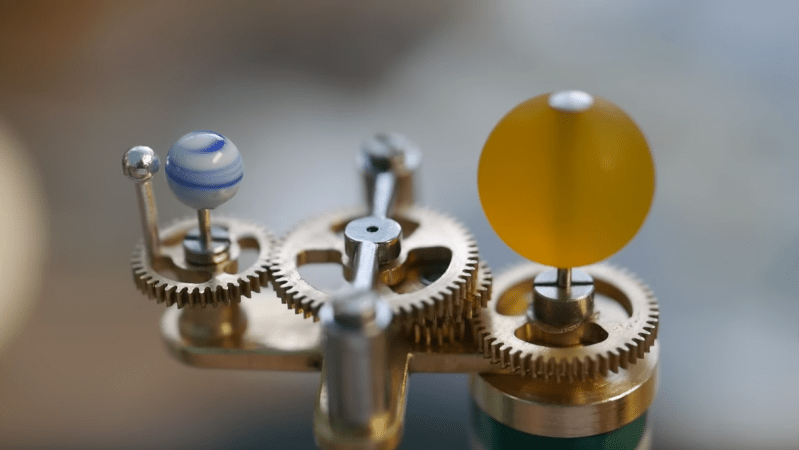Six tiny gears, a few fancy pins, and some clever casting are what it takes to build this tiny orrery. And patience — a lot of patience, too.
As model solar systems go, this one is exceptionally small. Its maker, [Mike] from Chronova Engineering, says it measures about 20 mm across and qualifies as the smallest orrery around. We can’t officiate that claim, but we’re not going to argue with it either. It’s limited to the Sun-Earth-Moon system, and while not as complete as some other models we’ve seen, it’s still exquisitely detailed. The gears that keep the Moon rotating 12.4 times around the Earth for each rotation of our home planet around the Sun are tiny, and take an abundance of watchmaking skill to pull off.
The video below shows the whole process, which is absolutely entrancing to watch. There are some neat tricks on display, from milling out the arms of the main wheel using a powered tailstock spindle to casting the Sun from resin in a silicone mold. The final model, with the model Earth and Moon spinning around the Sun on delicate brass wheels, is a visual treat.
We’ve seen some interesting stuff from Chronova Engineering lately, including this bimetallic tea timer.
















So, this is one of the parallel universes? Simplifyed of course.
While the craftsmanship presented rivals with Clickspring’s, the presentation somewhat lacks the appeal of the same competitor to our mecanichal hearts. And when I say competitor I only mean in this case someone who has the same or close skill, the same or close path though the museum of mechanical marvels.
Tick, tock, how many cogs you deamt about last night?, the sun is up, is time to start another clock to build it up.
It’s an interesting view on how people approach machining.
For example: place material in the chuck, mill the outside diameter, then replace the chuck with a microscope, center a drill on the microscope, put material back in, then check for alignment, then drill.
Without access to such precision tools, I would have drilled the center hole first, then milled the outside diameter – all without removing the piece from the chuck. The first rule of turning is that you avoid removing the work piece from the lathe because you’ll never get it back in exactly the same. Imprecise tools will make precise parts when you plan the order of operations accordingly.
But, if you have precision tools and instruments, you don’t necessarily have to – it just takes more time to keep checking and re-checking.
I think it’s a lovely model. I’m not sure if it is an Orrery. I think of an Orrery as a model with 7 planets about the sun. This seems more like a Tellurion. https://en.m.wikipedia.org/wiki/Tellurion
I had a design of my own. I started cutting it in acrylic and then ended up losing parts in a move.
https://drive.google.com/file/d/0B5HtJAcoR4PGR2Zva3dJNkpEa3M/view?usp=drivesdk&resourcekey=0-PKJTgtiw_qtBEwopyBXZGg
I like the materials and the workmanship. I envy your jeweler’s lathe and the collet set you have!
The largest orrery I have seen used to be in the basement of the Morehead Planetarium at UNC Chapel Hill. The planets were on trollies that ran on circular tracks mounted on the ceiling. They were illuminated. When the lights came down in the room, it created a splendid visual effect of planets floating in space. I imagine you would love it!